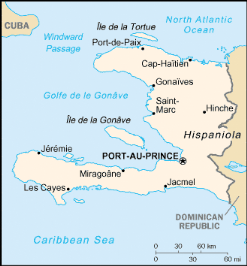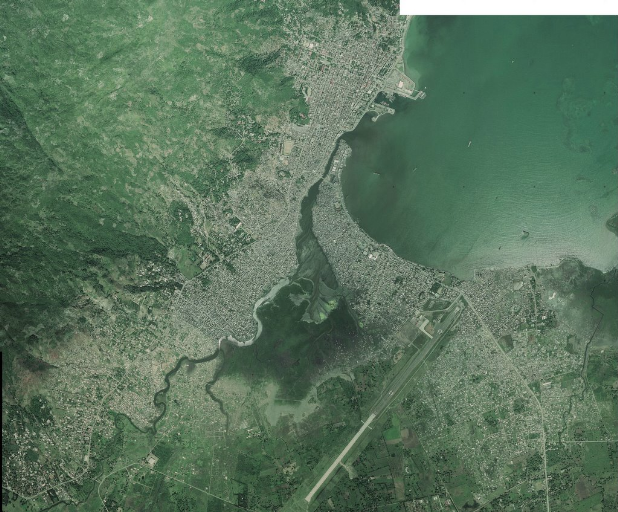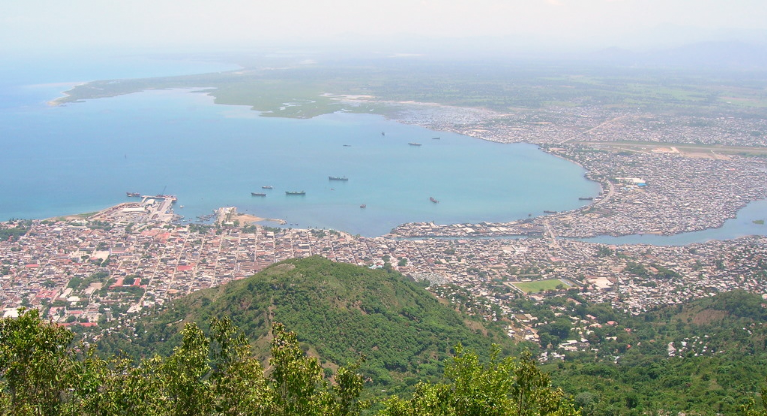1 Introduction
In the city of Cap-Haitien in Haiti, the British
Non-Governmental Organisation (NGO) Oxfam, the Belgian NGO PROTOS and the local
NGO GTIH have successfully obtained funding from the European Union (EU) in
order to conduct a 4-year project in Water and Sanitation, directed at poor
areas of the city. The project includes the rehabilitation
of the water supply system, creation of drainage channels for
rainwater, implement- ing a solid waste management scheme, a «social
engineering» part aimed at improving people's behaviour, and the
reinforcement of public services. In order to gain a better understanding of
how the sanitation part should be achieved, a 3-month research has been carried
out in Cap-Haitien.
1.1 Context of research
1.1.1 Haiti
Haiti is located on the island of Hispaniola in the
Caribbeans, West of the Dominican Republic (map on Figure 1.1 below). Despite
becoming the first independent «Black Republic» in 1804, it has since
known numerous authoritarian regimes and presidents elected for life. In the
second half of the 20th century, the ruling of the father and son Duvalier and
their secret police organisation (the «bogeymen»), then of
Jean-Bertrand Aristide have left Haiti as the poorest country in the Western
hemisphere and one of the Least Developed Countries (LOC, 2005).
In 2004, the Aristide government was overthrown by rebels,
starting a period of riots and violence until the intervention of the
multinational force from the United Nations,
the Minustah. In early 2006, elections were held and René
Preval became president, promising peace and stability. The Minustah is still
present in the country.
Haiti's economy is largely based on agriculture (70% according
to CIA, 2006), mostly small-scale subsistence farming, and informal economy.
Unemployment rates are be- tween 50% and 70% (ibid.). Cash crops include
coffee, mangoes, sugarcane and rice, though prices have collapsed due to
massive imports from the USA. The external debt has reached US$ 1.4 billion in
2006, 11% of the Gross Domestic Product (GDP), but Haiti will not qualify for
debt relief programmes before 2009; inflation is above 20%
and the GDP growth is negative since 2000, reaching now -3.5%.
With regard to these
figures, Haiti is «becoming poorer every day» (as it is
commonly heard locally).
Population is estimated at 8.53 million inhabitants, of which
2.5 to 3 million in the capital Port-au-Prince. The terrain consists mainly
of rugged mountains with small coastal plains and river valleys. Heavy
deforestation for charcoal production has af- fected all but 2% of the original
forest cover, leading to desertification, soil erosion and more recurrent
floods.

Figure 1.1: Map of Haiti
1.1.2 Cap-Haitien
Cap-Haitien is the second biggest city in Haiti after
Port-au-Prince; it comprises 120,000 inhabitants officially, but between
500,000 and 800,000 according to more recent sur- veys. Situated in the Nord
department, it used to be the historical centre of Haiti and the preferred
destination for tourism, with favoured beaches, a harbour for cruise ships and
historical sites. Since the 1970s, poverty and emigration from rural areas
have trans- formed the city. In the 1980s, Cités were constructed as
cheap housing areas close to
the mangrove, with basic infrastructure. However, areas have also
emerged at the same time on the mangrove, often by dumping solid waste in it to
create a firmer ground1.
The city now comprises the historical centre, with mountains
on the West and low- lying lands in the South and East. The city has
progressively expanded South and East over the mangrove, and West as slums
developed over the hillside. Figure 1.2 below presents an aerial view of the
city and Figure 1.3 is a view from a nearby hilltop. Hur- ricane Jeanne badly
affected the North of the country in 2004, causing heavy floods, mudslides and
about 3,000 deaths, a significant part of them in Cap-Haitien.
1 Source: interviews with local Oxfam staff.
An assessment was carried out in Port-au-Prince and Cap-Haitien
in 2003 for Oxfam
(Walden et al., 2003), focusing on water, sanitation and health.
It reported a deteriora- tion of health conditions and put forward
recommendations which were used to create
the present Water and Sanitation project.

Figure 1.2: Aerial view of Cap-Haitien.
The city centre is visible in the North, and the hills on the
West. Recent expansion of the city are visible in peri-urban areas in the
South, and dense slums are located in the
middle.
1.1.3 Oxfam's action
Oxfam has been doing development projects in Haiti for 30
years, and humanitarian in- terventions after the 2003-2004 crisis. In
Cap-Haitien, a project financed by DIPECHO has been supporting disaster
preparedness and mitigation work by the creation of Lo-
cal Committees for Civil Protection (KLPS) in order to reduce
vulnerability to natural disasters.
Oxfam has started a 4-year water and sanitation project in
summer 2006 together with partners PROTOS and GTIH, with funding from the
European Union, in order to improve access to safe water and sanitary
conditions in poor areas of Cap-Haitien. it includes the rehabilitation of the
water supply system in low-lying lands, where water is currently

Figure 1.3: View of Cap-Haitien above Mansui, looking towards the
East.
trucked; provision of sanitation services, including storm
water / wastewater drainage and solid waste removal; improving the health
behaviour of the targeted population; and building the capacity of the public
sector (Oxfam, 2006).
Regarding excreta management, the project includes a
«definition of an acceptable model of familial or multi-familial
latrine»; a budget of US$30,000 is allocated to la- trine building, for
about 100 pilot latrines. The project states that in target areas, open
defecation is practised by 44.2% of respondents2, plastic bags are
used by 33.8%, 19.4%
go to the sea and 2.6% use a latrine.
| 


